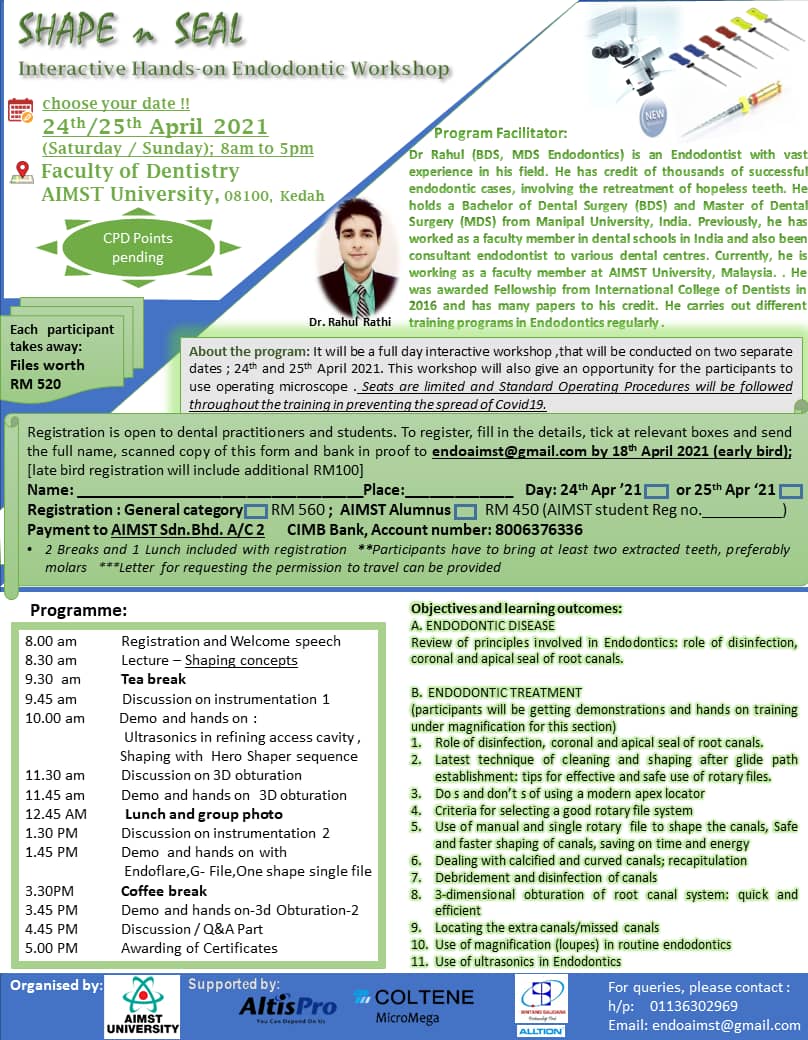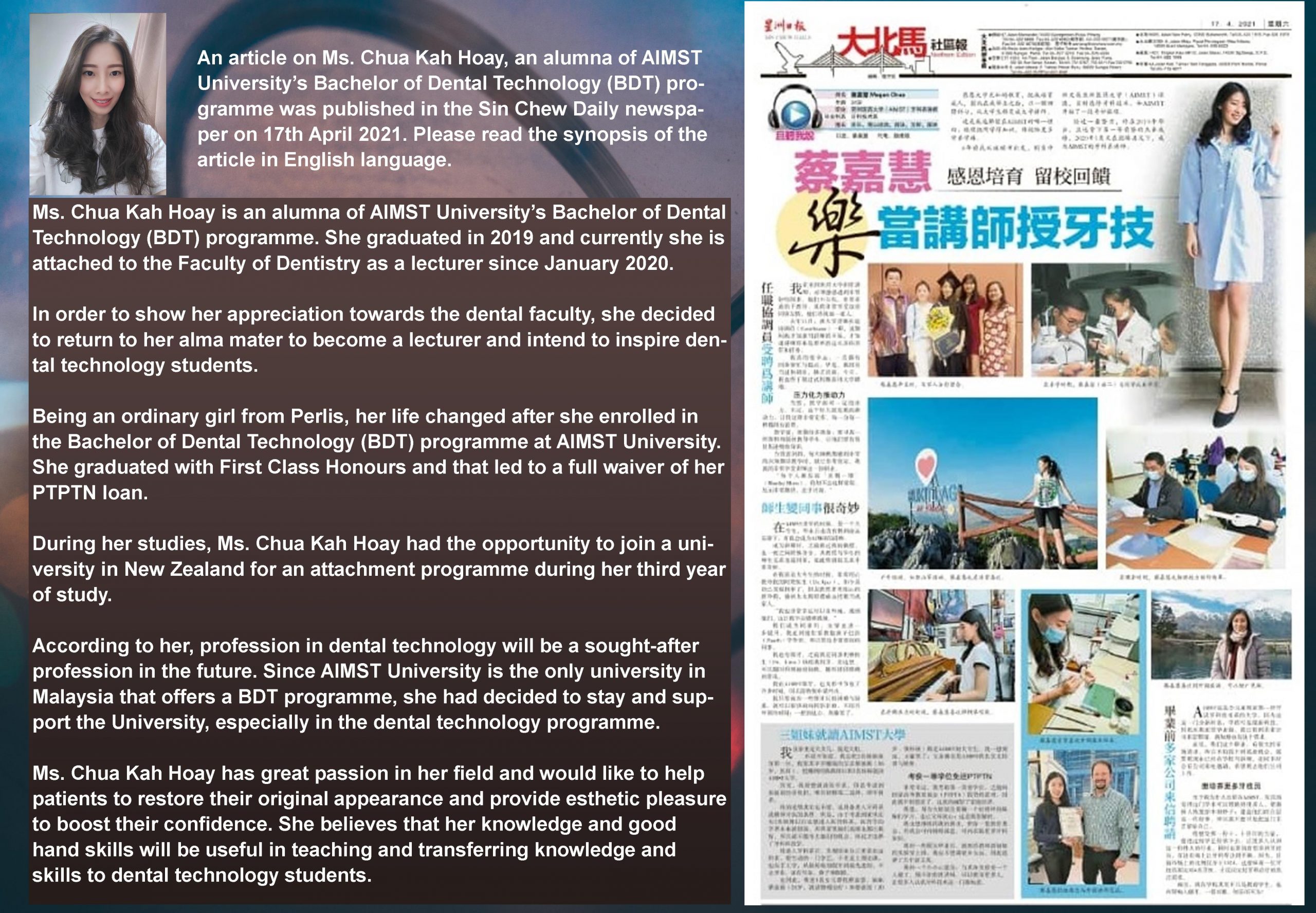SHAPE & SEAL – Interactive Hands-on Endodontic Workshop

‘The Tortoise and The Hare
Coordination mechanisms constitute part of good governance in government and a networked government allows for strategic collaboration not only within the public sector but across civil society. With reference to Aesop's Fable of The Tortoise and The Hare, it was proven that collaboration ensures victory for all. The Vice-Chancellor & Chief Executive of AIMST University, Professor Datuk Dr. John Antony Xavier in his opinion piece titled - Recall 'The Tortoise and The Hare' has suggested strategies for collaboration among various parties for better outcomes. The article was published in the columnist section of the News Straits Times (NST) on 20th April 2021. Click https://www.nst.com.my/opinion/columnists/2021/04/683671/recall-tortoise-and-hare to read.
A DAY WITH SPM STUDENTS
Venue: Jalan Baru Temple Penang
Date: 18 April 2021
Time:10am - 12pm
An article on Ms. Chua Kah Hoay, an alumna of AIMST University’s Bachelor of Dental Technology (BDT)
An article on Ms. Chua Kah Hoay, an alumna of AIMST University’s Bachelor of Dental Technology (BDT) programme was published in the Sin Chew Daily newspaper on 17th April 2021. Please read the synopsis of the article in English language.

AIMST INFO DAY
Event: "PROGRAM MEMBANTERAS JENAYAH" organised by MITRA
Venue: Light Hotel, Penang
Date : 17 April 2021
Time: 8am - 2pm
SPM STUDENTS MEET UP SESSION
Venue: HINDU SANGAM IPOH
Date: 17 April
Time: 6pm-8pm
Program Hari Terbuka
Venue: AIMST UNIVERSITY
Date: 17 April
Time: 8am - 12pm
Malaysia Education Fair
Venue: Setia Spice, Penang
Date: 17 & 18 April
Time: 11am - 6pm
Future for online learning
AIMST University’s Faculty of Pharmacy Deputy Dean (Postgraduate, Research, and Administration), Associate Professor Dr. Sundram M. Karupiah has come up with ways for educational institutions to overcome the digital divide among students and educators to stay relevant in the new normal of online teaching and learning. He had also listed the challenges that need to be dealt with if online learning is to be continued once the COVID-19 pandemic is over. The article titled ‘Future for online learning’ was featured in The Star’s ‘Letter to the Editor’ column on 14th April 2021. Click https://www.thestar.com.my/opinion/letters/2021/04/14/future-for-online-learning to read.
AIMST Knowledge Sharing Day
Event: Program Peningkatan Professionalisme Guru Bimbingan Kaunseling Daerah KMY
Venue: Jerai Hotel,SP
Date: 11 April 2021
Time: 8am - 2pm
AIMST INFO SHARING DAY
1FORCE AGAINST CRIME PROGRAMME ORGANISED BY MITRA
Venue: G HOTEL, PENANG
Date: 10 April 2021 & 11 April 2021
Time: 8am - 5pm
How Business Studies Help You Stay Competitive in the Covid-19 Pandemic?
Finance, accounting, management, marketing, economics, and other business-related subjects are among the most common fields of study at universities worldwide, especially at the graduate level. You probably know why this is the case – business graduates are in high demand worldwide (even during the Covid-19 Pandemic). Business impacts almost every aspect of modern society. Business degrees such as an MBA lead to a wide variety of professions that are often well-paid. Whether you want to work in fashion, finance, or something in between, you can't do without business if you intend to make a profit. It's either you hire someone who knows how to run the company or do the work yourself. Here's how business studies will help you remain competitive in today's world.
1. Improve Your Communication Skills
Even though most business practices are now performed virtually, writing a persuasive report or giving a winning pitch, or even writing the correct email, requires outstanding communication skills. While studying business, you can collaborate on various demanding projects with students from all over the world. Your viewpoints and perceptions may be divergent, and you can also disagree. To get the grade, you'll need to evaluate cases, react diplomatically to opposing views, and master the art of persuasion—all these help improve your communication skills which are essential in selling your brand.
2. Marketing: Know Your Target Market
Teachers exchange ideas with students to inspire them, politicians run campaigns to gain popularity, and job applicants must sell their qualifications to get hired. Making your concept (or application) stand out is not an easy task, but business studies will help you understand your target audience and how to relate to them creatively. This will come in handy if you're trying to get buy-in from your friends or investors, whether you own or work for a company.3. Budgeting and Accounting
Owing to bad financial management, sometimes even great companies struggle to thrive. Don't be put off by financial principles if you want to start your own company. Now that people are forced to start a business due to global downsizing, business studies will teach you the fundamentals of budgeting and accounting, allowing you to feel confident and prepared to improve your company's results.4. Unleash Your Inner Entrepreneur
Students are increasingly attending business school to learn how to start their dream company. Being your boss has a lot of advantages and is becoming increasingly important in today's world. On the other hand, being a good entrepreneur, necessitates ingenuity, innovation, and a solid execution plan. Attending the right business school will help you grow your entrepreneurial skills and test your ideas. Who knows, maybe in class you will find your potential business partner.5. Investment and Finance Helps You Understand How the World Works
Financial loans are an option for several large transactions, such as purchasing a home, a car, or paying for a business school degree. How do you know when it's safe to take out a loan? Similarly, you may want to invest in stocks, shares, or real estate at some stage in your life. What do you put your money into, and what considerations should you think about? A business Bachelor’s degree or an MBA will provide you with a solid understanding of basic economic concepts, how global issues impact economies, and how to evaluate a company's financial health. This, when combined, will assist you in making more informed investment decisions and, eventually, how to increase your return on investment.

